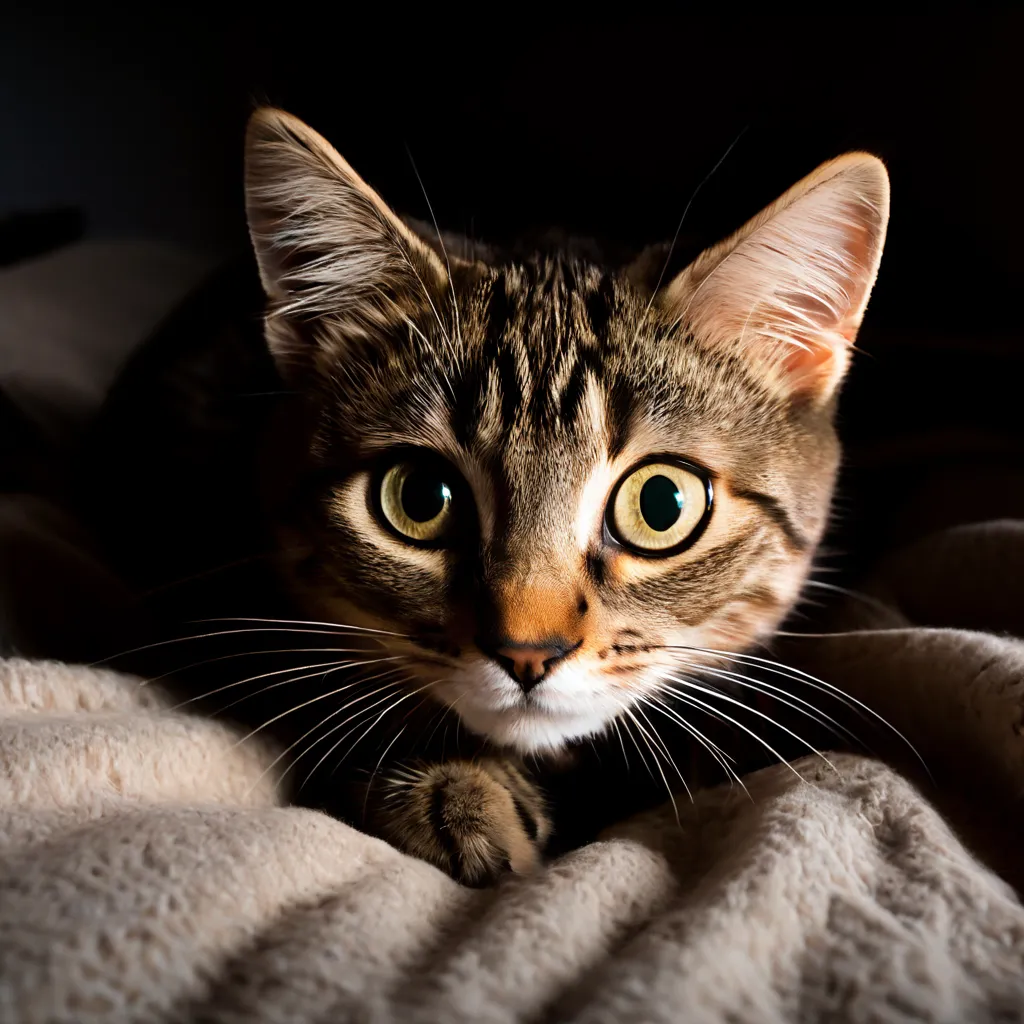Introduction
Are you wondering if your cat is scared of you? Cats can be subtle in showing their fear, but there are several signs and behaviors that can indicate if your cat is feeling anxious or fearful around you. Understanding these signs is crucial in building a strong and trusting relationship with your feline companion.
Cats communicate primarily through body language, and their behavior can change significantly when they are scared or fearful. From physical signs such as tail flicking, ear positioning, and pupil dilation to changes in vocalization and behavior, there are many ways to tell if your cat is scared of you.
In this article, we will explore the physical signs of fear in cats, how their vocalization changes when they are scared, common behaviors that indicate fear, possible reasons why your cat may be scared of you, and how to tell if your cat is scared of you specifically. By understanding these signs and behaviors, you can take steps to create a safe and comfortable environment for your cat, helping to strengthen your bond and build trust.

By recognizing the signs of fear in cats, you can take the first step in creating a more harmonious and loving relationship with your feline companion. So, let’s dive in and explore the world of cat behavior and body language to better understand our feline friends.
What are the physical signs of fear in cats?
When it comes to recognizing fear in cats, it’s essential to pay attention to their body language and physical cues. Cats are sensitive creatures that can become scared or fearful in certain situations, and as a responsible cat owner, it’s crucial to be able to identify these signs of fear in your feline friend.
Recognizing Physical Cues in Cats
Cats communicate their fear through subtle physical cues. By recognizing these signs, you can better understand and address your cat’s anxiety. Look for the following scared cat body language:
- Flattened Ears: When a cat’s ears lay flat against its head, it signals distress or fear.
- Springing: A cat who is scared suddenly might pop right up in the air before bolting.
- Shaking: Like us, cats might shake or tremble out of fear.
- Acting Skittish: Cats might act erratic or neurotic when they’re scared.
- Dilated Pupils: A cat that is scared or in pain can present enlarged round pupils.
- Tail Position: The cat’s tail may be close to its body, either curled forward or positioned close to its body while standing.
- Vocalization: The cat may also vocalize fear through meowing, growling, or yowling.
- Halloween Pose: A scared cat may display the “Halloween pose,” where it arches its back, puffs out its fur, and displays its claws.
By being aware of these physical signs, you can take steps to help your cat feel safe and secure. Remember, every cat is different, so it’s essential to get to know your cat’s unique personality and behavior to better understand their fear responses.
How does a cat’s vocalization change when they are scared of you?
When a cat is scared of you, their vocalization can change in several ways. Here are some common changes you might notice:
- Unusual vocalizations: Cats may make unusual sounds such as growling, wailing, or howling when they are scared or threatened.
- Changes in tone: A cat’s meow can change in tone when they are scared, becoming more high-pitched or urgent.
- Hissing: Cats may hiss when they are scared or threatened, accompanied by changes to their body posture.
- Snarling: A snarl sound can occur during a fast inhalation, indicating that the cat is feeling threatened or scared.
- Changes in vocalization patterns: Cats may vocalize more frequently or in different patterns when they are scared, such as meowing repeatedly or making a series of high-pitched sounds.
These changes in vocalization can be an important indicator of a cat’s emotional state and needs. By paying attention to these changes, you can better understand when your cat is feeling scared or threatened and take steps to comfort and reassure them.

It’s also important to note that changes in vocalization can be accompanied by other physical signs of fear in cats, such as changes in body posture, hiding, or avoiding eye contact.
What are the possible reasons why your cat is scared of you?
Cats can be scared of their owners for a variety of reasons. Here are some possible explanations:
- Sickness or injury: Cats may become scared of their owners if they are in pain or discomfort due to a medical condition. For example, a cat may associate its owner’s touch with pain if it has a sore spot or injury.
- Lack of socialization: Kittens that are not socialized properly may become fearful of their owners and other people. This is because they are not exposed to different environments, people, and experiences, making them more prone to anxiety and fear.
- Changes in environment: Cats are creatures of habit and may become scared if their environment changes suddenly. This could be due to a move to a new home, changes in furniture or decor, or even a new pet or family member.
- Negative experiences: Cats may associate their owners with negative experiences, such as punishment or rough handling. This can lead to fear and anxiety around their owners.
- Genetic predisposition: Some cats may be more prone to fear and anxiety due to their genetic makeup. For example, some breeds are more skittish or nervous than others.
It’s essential to remember that every cat is different, and what works for one cat may not work for another. If you’re concerned about your cat’s behavior, it’s always best to consult with a veterinarian or animal behaviorist to rule out any underlying medical issues.
How can you tell if your cat is scared of you specifically?
Cats can be mysterious creatures, and it can be difficult to understand their behavior at times. If you’re wondering whether your cat is scared of you specifically, there are a few signs to look out for.
- Body Language: A scared cat will often exhibit certain physical signs that indicate fear. Be aware of their body posture, as a cowering or hunched position may suggest they’re scared. Shaking or trembling is another sign of fear in cats, similar to humans.
- Acting Skittish: Cats might act erratic, jumpy, or neurotic when they’re scared. They can become easily startled and jump away from sudden movements or sounds. Pay attention to your cat’s behavior around you and other animals, as these can be indicators of fear.
- Dilated Pupils: A cat that is scared or in pain can present enlarged, round pupils. This change in eye expression can indicate that your cat feels threatened.
- Increased Vocalization: Excessive meowing or vocalization is a behavior that cats show when they are feeling stressed. This is sometimes directed toward people, so if your cat has become noisier, it could be trying to communicate their distress.
To help your cat feel more comfortable and safe, you can create a welcoming environment with cozy blankets and use pheromone or calming sprays. Engage with your cat through activities they enjoy, and avoid forcing them to be something they’re not. With patience and understanding, you can build a trusting relationship with your furry friend and identify any signs of fear.
In conclusion, if your cat exhibits these behavioral indicators, it might suggest they are scared of you. It is essential to be attentive and provide a safe and comfortable environment to help them feel more secure.
Conclusion
In conclusion, recognizing the signs that your cat is scared of you can be a challenging but crucial step in building a stronger and more loving relationship with your feline companion. By understanding the physical signs of fear, changes in vocalization, common behaviors, and possible reasons behind their fear, you can take the necessary steps to create a more comfortable and safe environment for your cat. Remember, every cat is different, and it’s essential to tailor your approach to your cat’s unique needs and personality. With patience, love, and understanding, you can help your cat feel more secure and build a lifelong bond with them.
By following the tips and guidelines outlined in this article, you can:
- Identify the physical signs of fear in your cat, such as tail flicking, ear positioning, and pupil dilation
- Recognize changes in your cat’s vocalization, such as hissing, growling, or meowing
- Understand common behaviors that indicate fear, such as hiding, avoidance, or aggression
- Explore possible reasons behind your cat’s fear, such as past trauma, medical issues, or changes in their environment
- Develop a plan to help your cat feel more comfortable and secure around you
Remember, building trust with your cat takes time and effort, but with persistence and patience, you can create a stronger and more loving relationship with your feline companion.
















